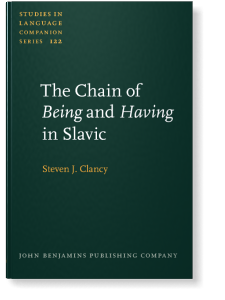The Chain of Being and Having in Slavic
The complex diachronic and synchronic status of the concepts be and have can be understood only with consideration of their full range of constructions and functions. Data from modern Slavic languages (Russian, Czech, Polish, Bulgarian) provides a window into zero copulas, non-verbal have expressions, and verbal constructions. From the perspective of cognitive linguistics, be and have are analyzed in terms of a blended prototype model, wherein existence/copula for be and possession/relationship for have are inseparably combined. These concepts are related to each other in their functions and meanings and serve as organizing principles in a conceptual network of semantic neighbors, including give, take, get, become, make, and verbs of position and motion. Renewal and replacement of be and have occur through processes of polysemization and suppletization involving lexical items in this network. Topics include polysemy, suppletion, tense/mood auxiliaries, modality, causatives, evidentiality, function words, contact phenomena, syntactic calques, and idiomatic constructions.
[Studies in Language Companion Series, 122] 2010. xvii, 297 pp.
Publishing status: Available
Published online on 10 December 2010
Published online on 10 December 2010
© John Benjamins Publishing Company
Table of Contents
-
List of tables | pp. ix–x
-
List of figures and capsules | pp. xi–xii
-
Abbreviations and symbols used | pp. xii–xiv
-
A note on the content and format of this book | pp. xv–xvii
-
Chapter 1. Why be and have? | pp. 1–8
-
Chapter 2. The relationship between be and have | pp. 9–66
-
Chapter 3. Be in the modern Slavic languages | pp. 67–120
-
Chapter 4. Have in the modern Slavic languages | pp. 121–158
-
Chapter 5. Grammaticalization of be and have | pp. 159–230
-
Chapter 6. Language contact and borrowing | pp. 231–250
-
Chapter 7. Conclusions | pp. 251–264
-
Appendix Data sources | pp. 265–284
-
Bibliography | pp. 285–290
-
Author index | pp. 291–292
-
Language index | pp. 293–294
-
Subject index | pp. 295–298
Cited by (12)
Cited by 12 other publications
Ivanová, Martina
Luraghi, Silvia, Chiara Naccarato & Erica Pinelli
Rozwadowska, Bożena, Arkadiusz Nowak & Anna Bondaruk
2020. Chapter 1. Psych verbs. In Beyond Emotions in Language [Linguistik Aktuell/Linguistics Today, 263], ► pp. 1 ff. 
Bartelik, Piotr
Cahlon, Rammie
2019. Chapter 8. On habitual periphrasis in Cuzco Quechua. In Nominalization in Languages of the Americas [Typological Studies in Language, 124], ► pp. 341 ff. 
Juge, Matthew L.
Seres, Daria & M.Teresa Espinal
Szcześniak, Konrad
Seržant, Ilja A.
2015. Categorization and semantics of subject-like obliques. In Subjects in Constructions – Canonical and Non-Canonical [Constructional Approaches to Language, 16], ► pp. 175 ff. 
Panevová, Jarmila & Magda Ševčíková
2014. Delimitation of information between grammatical rules and lexicon. In Dependency Linguistics [Linguistik Aktuell/Linguistics Today, 215], ► pp. 33 ff. 
[no author supplied]
[no author supplied]
This list is based on CrossRef data as of 26 september 2024. Please note that it may not be complete. Sources presented here have been supplied by the respective publishers. Any errors therein should be reported to them.
Subjects
Main BIC Subject
CF/2AG: Linguistics/Slavic (Slavonic) languages
Main BISAC Subject
LAN009000: LANGUAGE ARTS & DISCIPLINES / Linguistics / General
